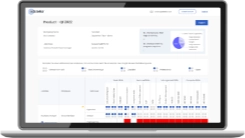
Workplace stress isn’t an occasional bad day anymore it’s become the norm. Around 80% of employees start their day already exhausted, juggling high-pressure workloads that make it difficult to stay focused or perform at their best. And the cost? It’s not just personal it’s organizational.
The numbers are hard to ignore. 8 out of 10 employees say their job causes stress. U.S. businesses lose over $300 billion every year to stress-related challenges, with $183 billion tied directly to drops in productivity. It’s not a small issue it’s quietly undermining performance, engagement, and retention across the board.
At the same time, technology is transforming the way we work. AI, automation, and new tools are speeding things up and opening doors to innovation but they also demand more from people. More adaptability. More emotional resilience. More focus. In such a fast-moving environment, organizations need to think beyond perks and quick fixes.
Supporting employee well-being isn’t optional anymore it’s essential. HR, people leaders, and executives aren’t just in a position to help they’re responsible for creating the kind of culture where people can keep up with the pace of change without burning out in the process.
In the sections ahead, we’ll break down the root causes of stress, explore practical strategies organizations can apply, and look at how leaders can create a work environment where performance and well-being go hand in hand.
Understanding the Root Causes of Workplace Stress
Workplace stress arises when the psychological demands of a job outweigh an individual’s capacity to manage them. It’s a sustained sense of strain that, over time, can compromise focus, motivation, and long-term well-being. In the short term, it creates mental and emotional fatigue. Left unchecked, it becomes a serious risk to both employee health and organizational effectiveness.
The most common sources of work-related stress include:
1. Low Compensation and Financial Pressure
When pay doesn’t reflect the level of effort, responsibility, or rising cost of living, employees feel undervalued. Financial stress outside work compounds the mental load at work, making every task feel heavier.
51% of workers in low-paying jobs says their job has a negative impact on their stress level
2. Excessive Workloads and Unrealistic Expectations
Consistently high demands without enough time, resources, or recovery lead to chronic overextension. Employees end up feeling like they’re constantly behind, even when they’re doing their best.
80% of employees report managing high-stress workloads that hurt their ability to focus and stay productive.
3. Lack of Career Growth or Advancement
When employees don’t see a path forward, they don’t just disengage they leave. Stress accounts for nearly 40% of job turnover, and replacing one employee can cost up to 120-200% of their salary making this a costly consequence of inaction.
4. Insufficient Social and Team Support
Isolation at work whether due to poor collaboration, weak leadership, or lack of connection amplifies stress. Having no one to talk to, vent to, or lean on during busy periods can fast-track employee burnout.
Relationships are generally smooth but declining. Most working adults (78%) report having a positive relationship with their co-workers, and nearly 72% say the same about their boss. Notably, the quality of both types of relationships has declined over the past few years, possibly signaling a trend
5. Limited Autonomy and Decision-Making Power
When employees have no say in how they prioritize or complete their work, it breeds frustration. A lack of autonomy can be especially demotivating in roles that demand creativity or flexibility.
6. Unclear Expectations and Conflicting Priorities
Stress spikes when employees don’t know what success looks like. Ambiguity around performance expectations, frequent changes in direction, or competing demands lead to second-guessing, wasted effort, and chronic anxiety.
7. Difficulty Adapting to Rapid Change
Shifts in tools, roles, processes, and business strategies are constant and not everyone adapts at the same pace. When change feels unmanageable or support is lacking, it becomes a major stressor.
Want to dive deeper into how workplace stress hurts performance and productivity?
Read More: How Stress Affects Employee Productivity →
8 Simple Yet Powerful Ways to Tackle Employee Stress at Work
Addressing workplace stress isn’t just a leadership trait it’s an operational necessity. While awareness is the first step, what truly matters is action. Organizations must move beyond surface-level solutions and build systems that consistently reduce pressure, improve employee experience, and promote sustainable performance.
.webp)
This section outlines actionable strategies organizations can take to tackle stress at the root from how work is structured to how well-being is supported.
1. Assess and Rebalance Workloads Across Teams
When workloads consistently exceed capacity, stress becomes inevitable. It’s not enough to assume managers will handle it HR and Operations must take a structured approach to reviewing how work is distributed. This includes evaluating team responsibilities, delivery timelines, and available resources. When employees are juggling competing priorities with unrealistic expectations, it’s not a performance issue.
Redistributing work, automating repetitive tasks, or hiring additional support are strategic decisions tied directly to stress management. What’s equally important is creating a culture where employees feel safe admitting they’re overloaded. Silence doesn’t always signal stability it may indicate someone is overwhelmed and unsure how to ask for help.
2. Build a Visible and Accessible Mental Health Support System
Employees are far more likely to suffer in silence when mental health is seen as a private matter rather than an organizational priority. Employers must lead with openness and promote mental health awareness across all levels of the organization. This starts with HR and CHROs ensuring employees know how to access resources such as Employee Assistance Programs (EAPs), therapy coverage, or mental health platforms.
Mental health struggles cost more than treatment alone. For every 47 cents spent on care, 53 cents is lost to absenteeism, presenteeism, and reduced performance making early and visible support systems not just compassionate, but critical to productivity and cost savings.
Even if formal benefits are limited, pointing employees toward free self-care apps or community resources makes a difference. Leaders should normalize mental health discussions in onboarding, internal communication, and one-on-one conversations so support is not hidden, but expected and encouraged.
3. Offer Flexible Schedules and Work Locations
Rigid work schedules and lack of autonomy contribute significantly to workplace stress. HR and senior leadership can help by introducing flexible start and end times, enabling remote or hybrid work. It’s not about reducing accountability it’s about improving work-life balance.
When people have control over their time, they’re more likely to manage their energy, stay productive, and maintain emotional resilience. This approach demonstrates trust, reduces presenteeism, and gives employees the space they need to manage both personal and professional responsibilities.
4. Clarify Roles, Expectations, and Priorities
Uncertainty and ambiguity are major stress triggers. Employees who don’t know exactly what’s expected of them or who face frequent shifts in priorities spend a significant amount of time second-guessing their choices and managing conflicting demands. This creates cognitive overload that damages morale and performance.
A Gallup study found that 50% of employees don’t know what’s expected of them at work.
HR should own job description accuracy, L&D can provide training on role clarity, and managers must ensure team goals and KPIs are aligned. Regular check-ins and cross-team coordination help maintain clarity. When employees know what success looks like, they’re better equipped to stay focused and stress-free.
5. Make Wellness Programs a Core Part of the Workweek
Wellness should never be treated as an afterthought. In organizations that prioritize employee health and well-being, wellness practices are embedded into the rhythm of work not offered as occasional perks after stress has taken a toll. This includes providing access to physical and mental health resources, guided yoga or mindfulness sessions, healthy office snacks, and even movement-friendly meeting formats.
HR can lead program design, L&D can help integrate wellness into team workflows and calendars, and wellness committees can drive participation and engagement across departments. When these functions work together, wellness becomes a shared responsibility not just a checkbox.
Encouraging daily, low-effort wellness habits not only supports healthy living it also helps reduce long-term costs. Employees under prolonged stress incur nearly 50% more in healthcare expenses, making wellness initiatives a smart financial decision as much as a people-first one.
To take it a step further, include stress management activities as a regular, visible part of your wellness programming.
6. Design Workspaces That Support Focus and Recovery
Environmental stressors such as loud open spaces, poor lighting, or cramped desks can quietly drain employee energy. Employers should proactively design both physical and virtual workspaces that support focus and recovery.
In-office environments benefit from natural light, quiet zones, plants, ergonomic furniture, and informal recharge areas. For remote teams, offer stipends for home office setups and provide guidance on creating spaces that promote calm.
Facilities teams can lead workspace planning and upgrades, HR ensures alignment with employee needs, and IT supports remote ergonomics and digital well-being tools. Creating a supportive workspace is a simple but powerful way to improve overall well-being and promote sustainable productivity.
7. Normalize Time Off and Prioritize Recovery
Offering time off is one thing creating a culture where employees feel safe using it is another. Many employees hesitate to disconnect due to guilt, fear of falling behind, or subtle workplace expectations that reward overwork. But sustained performance depends on recovery.
The cost of ignoring this is substantial. In large organizations, absenteeism driven by stress and employee burnout contributes to over $3.6 million in losses annually. That’s not just time lost it’s productivity, morale, and momentum slipping away.
HR must reinforce clear policies and encourage usage, executives need to model healthy time-off behavior, and people managers should check in regularly and support workload redistribution when team members take leave. Promoting a recovery culture sends a clear message rest isn’t a luxury, it’s a business enabler.
8. Confront and Eliminate Toxic Workplace Behaviors
No wellness strategy will succeed if the overall culture is unhealthy. Micromanagement, favoritism, passive-aggressive communication, or exclusionary practices all generate chronic stress no matter how many wellness perks are in place.
Stress doesn’t just impact mood it affects safety. Stress-related workplace accidents cost nearly twice as much as non-stress-related ones, increasing operational and legal risk for organizations that ignore cultural toxicity.
CHROs and HRBPs must act swiftly to flag early signs of toxicity, while Compliance and Legal teams ensure that due process is followed. Anonymous surveys, regular feedback loops, and open-door policies should be in place to identify issues early.
Once surfaced, these behaviors must be addressed through clear policies, visible accountability, and continuous training on respect, inclusion, and psychological safety. Stress management in the workplace begins with protecting employees from unnecessary harm and that requires action, not just intention.
Read More: Toxic Work Environment: Signs, Causes, and How to Fix It
The Role of Leadership in Reducing Employee Stress
While organizations can create policies, it’s leaders who shape how those policies are lived every day. Managers, supervisors, and team leads play a frontline role not just in meeting goals, but in protecting the emotional and mental bandwidth of their teams.
.webp)
This section focuses on what leaders must do in practice. Because managing workplace stress isn’t just HR’s job it’s a leadership responsibility that starts with awareness and shows up in daily actions.
1. Spot the Signs of Employee Burnout Early
Employee burnout builds up over time and leaders are often the first line of defense in identifying when something is wrong. But spotting burnout isn’t just about watching for missed deadlines or drop in performance. Stress shows up in many ways: irritability, disengagement, difficulty focusing, reduced motivation, or even physical signs like fatigue and frequent absences.
Supervisors should actively observe these signals and avoid assuming silence means everything is fine. When in doubt, check in. Ask open-ended questions like:
- “How are you managing your workload lately?”
- “Are there any recent challenges we should talk through?”
Just asking can make a significant difference and in some cases, help prevent a crisis before it escalates.
2. Lead with Empathy, Not Assumptions
Workplace empathy is one of the most effective tools a leader has when managing stress. Leaders should remind team members that they are not alone, that stress is a valid and common experience, and that seeking help is not a weakness. Simple affirmations like “It’s okay to feel overwhelmed,” or “You’re not expected to power through everything alone,” can create a more psychologically safe environment.
Managers and team leads can share their own experiences with stress when appropriate it humanizes the conversation and encourages authenticity. It also means understanding that people won’t always be operating at full capacity and being flexible with expectations during challenging times.
3. Encourage Open Dialogue and Active Listening
Reducing workplace stress starts with making it safe to talk about. As the first point of contact for employees, managers and supervisors should regularly create space for honest, two-way conversations not just performance reviews or project updates. That means checking in individually, hosting group discussions where concerns can be voiced, and being genuinely available to listen.
When someone opens up, the role of a leader isn’t to immediately solve the problem it’s to acknowledge and validate the experience. Use phrases like:
- “That sounds really tough thank you for sharing it with me.”
- “What do you need from me right now?”
Equally important is how you listen. Don’t interrupt. Make eye contact. Paraphrase what you heard to show understanding. And if someone doesn’t want to share? That’s okay point them toward trusted support resources instead.
4. Set Boundaries and Respect Time Off
Many employees are stressed not because they don’t have time off but because they don’t feel safe using it. Leaders need to actively model and support boundaries around work hours, time off, and mental health days.
This includes:
- Avoiding non-urgent emails after hours
- Encouraging full disconnection during vacations
- Respecting flexible schedules based on personal needs
If an employee is hesitant to take time off, team leads should initiate the conversation. Ask if workload redistribution is needed or offer help prioritizing tasks. Demonstrating that time off is respected not penalized helps reinforce a culture where recovery is normalized and employee burnout is prevented.
5. Provide Emotional and Practical Support When Needed
Leadership isn’t just about encouragement it’s about knowing when and how to offer tangible support. If an employee is struggling with workload or personal challenges, consider adjusting responsibilities, extending deadlines, or providing flexibility where possible.
Managers and supervisors should also stay informed about available mental health resources from internal EAPs to public support services or mental health support hotlines. Leaders don’t need to become therapists but they do need to know where to refer to employees in distress, and do so with empathy and discretion.
Lastly, don’t forget your own well-being. Monitor your own stress levels, practice self-care, and take time off when needed. You can’t support others sustainably if you’re overwhelmed yourself. Leadership starts with example and modeling healthy behavior is one of the most effective ways to inspire it in others.
Frequently Asked Questions
Final Thoughts
Workplace stress is no longer a silent undercurrent it’s a critical organizational challenge that, when left unchecked, can quietly erode employee well-being, performance, and retention. What starts as small, overlooked signals missed deadlines, low morale, fatigue can spiral into employee burnout, turnover, and disengagement that ripple across teams and cultures.
But stress is not inevitable. It can be managed, and more importantly, prevented with the right strategies in place. From recalibrating workloads and enabling mental health conversations to empowering leaders through training, every action counts. And when organizations need guidance, platforms like Edstellar offer more than just training they provide structured learning interventions and tools like the Skills Matrix to identify gaps, track development, and build the behavioral and leadership competencies that support long-term resilience.
Building a workplace where people can thrive mentally, emotionally, and professionally is possible. It takes awareness, action, and a commitment to put people first. Start small. Start today. And if you're ready to take the next step, connect with Edstellar to explore how your teams can become stronger, healthier, and more future-ready.
Explore High-impact instructor-led training for your teams.
#On-site #Virtual #GroupTraining #Customized
Edstellar Training Catalog
Explore 2000+ industry ready instructor-led training programs.

Coaching that Unlocks Potential
Create dynamic leaders and cohesive teams. Learn more now!


Want to evaluate your team’s skill gaps?
Do a quick Skill gap analysis with Edstellar’s Free Skill Matrix tool

Stay informed on L&D best practices
Get periodic updates on learning and development industry trends, expert insights, success stories and innovative training practices from Edstellar.
.svg)
Featured Post
.webp)
Contact Us
Submit your Training Requirements below and We'll get in touch with you shortly.
.svg)



.svg)



.svg)

.svg)
.svg)
.svg)

